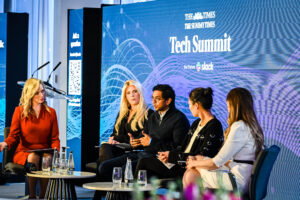Imagine if society had invented the means for you to work continually in what previously was down-time.
Imagine if you were urged to follow the path of optimisation and self-improvement in all aspects of life, if you were continually overwhelmed by information and options, if you had to keep all of this in the air despite two economic crashes in a decade and the demands of a global pandemic.
For many of us today, this is the modern reality. But the “Stabilisers” have had enough. Coined by trend forecasting company WGSN, they are “a cohort that is prioritising stability across all aspects of their life as a reaction against desynchronisation and feelings of chronic uncertainty”.
Who are they?
Stabilisers typically span millennials and Generation-X, according to WGSN, and they are maxed-out.
This group is burned-out by the cult of productivity, stressed-out by social sharing and by information overload. It has reached a nadir with the quest for wellness, is anxious about existential threats and feels dislocated from its locality in an era of digital choice.
As a reaction, Stabilisers are embracing “radical acceptance” of the present moment - a theory developed by therapist Dr Marsha Linehan. That means seeing and accepting the reality before them, and simply finding the most effective route to move forward.
The Stabilisers are a movement pursuing antifragility through acceptance, focus, fewer obligations and, with it all, a more peaceful, more meaningful life.
Where do they come from?
The 2008 economic crash destabilised many. Add in fear and anxiety caused by terrorism, coronavirus, ecological threat and the effortless online spread of negative messages.
Technology allows us to be always-on, to fill our unfilled moments with work, tasks or duties. But Stabilisers believe that, far from creating more time as promised, the onward march of seemingly-empowering new collaboration and on-demand services instead creates new obligations that immediately fill that time. They have noticed a disconnect between their to-do list and the time in which to complete it - and they want that time back.
The COVID-19 pandemic, in particular, has left many people feeling without agency, at the mercy of global events. Meanwhile, the technology which purports to liberate individuals also threatens to reduce shared societal moments, whether it is the weekly grocery shop or watercooler live TV moments, leading to a feeling of desynchronisation.
Stabilisers aim to accept the things over which they can realistically exert control, reject the over-complicated and place their remaining ambitions more meaningfully, closer to home.
What does the data say?
According to a ComRes survey for Perkbox, 38% of people in the UK monitor their daily step count using a fitness tracker - 58% of them aim to hit 10,000 steps a day.
That is an admirable antidote to the dangers of a sedentary lifestyle. The problem? Seventy-one percent of users never reach the target. Goals are important, but trails of aspiration “debt” like this can actually wind up disempowering consumers.
On their own, such failures may not seem significant. But failure to hit goals in one area of life are likely to be blamed on demands in other areas. Stabilisers feel they have been suffering from multi-dimensional overwhelm.
In a recent survey of Financial Times readers, those in the UK were most likely in the world (65%) to say COVID-19 has harmed their mental health, involving pressure to “achieve unachievable objectives” and a feeling that “the workload is insurmountable”.
The Stabilisers are opening the door out of these feelings by switching to accepting the unchangeable present moment and working to improve the next one through simplification and focus.
How to talk to them?
Marketers draw Stabilisers’ ire by bombarding them, challenging them to step up, provoking them to make ambitious change, adding to their to-do list or by confusing them.
Use empathy to relate to what sometimes can seem like the insurmountability of modern life, and use economy to empower Stabilisers to focus on the important goals they know they can and must control.
For them, simplicity matters. For instance, communicators should combat decision fatigue by presenting radically fewer options - a challenge for ecommerce marketplaces like Amazon but considerably more achievable for direct-to-consumer product owners themselves.
Stabilisers value minimalism - in the spaces and choices over which they can exert control, they swerve an excess of options, so declutter your communications. Think about how Apple’s streamlined product line-up itself leads to a minimal product marketing plan, and how the brand itself also stands back from engaging in the same all-out advertising war that many rivals do.
For Stabilisers, life is busy. Use information design to streamline your audience’s available options, alleviate stress and smooth anxiety. Less is more and constant messaging is overwhelming, so use your omni-channel system of record to accurately frequency-cap consumers’ exposure.
Fight overwhelm and appease the Zen-seekers.








